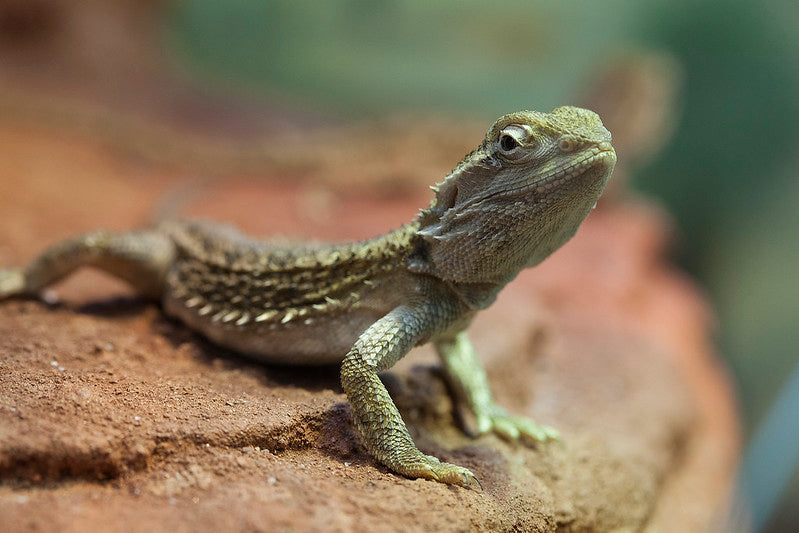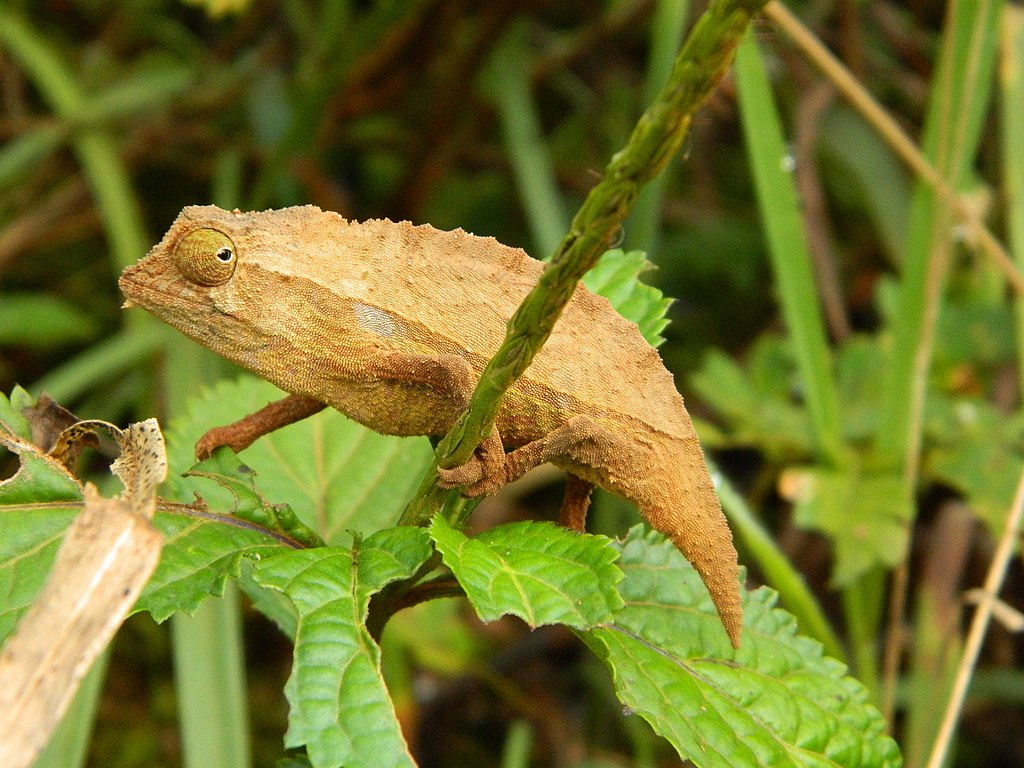Rankins dragons (Pogona henrylawsoni) are small- to medium-sized diurnal, terrestrial lizards that can be found in central Queensland, Australia. They are restricted to the area’s black soil plains habitats, with sparse, dry vegetation. This lizard is best known as a Rankins dragon, but is also documented as the blacksoil bearded dragon, dumpy dragon, Downs bearded dragon, Lawson’s dragon, pygmy bearded dragon, or dwarf bearded dragon.
Adult Rankins dragons bear a strong resemblance to juvenile central bearded dragons. They average 12” long, and some visual differences between them and bearded dragons include: a bulbous head, less of a “beard” under the chin, small spiky scales interspersed on the back, and short spikes at the base of the tail, which is relatively short. Coloring ranges from gray-brown to yellow-brown, with a pale underside. Adults may be patternless or they may have a series of pale oval blotches on either side of the spine. The tail typically has a ringed pattern.
Rankins dragons are less popular than central bearded dragons as pets, but they are still common pet lizards worldwide. They make a good alternative to bearded dragons for people who like the idea of a bearded dragon, but struggle with limited available space.
How much space do Rankins dragons need?
A single Rankins dragon should be housed in no smaller than a 36”L x 18”W x 18”H enclosure (~40 gallons). However, if you can provide a larger enclosure, do it!
Cohabitation is optional. While Rankins dragons can do perfectly well housed alone, it is possible to house them communally if you take the right precautions. The enclosure size needs to be increased to at least 48” x 24” x 24”, and avoid housing multiple males together, as they may fight and injure one another. Small groups of similarly-sized females are the safest option. One male can be housed with one to two females, but only if you intend to breed.
Do Rankins dragons need UVB?
Yes! Rankins dragons are diurnal, which means that they are most active during the day, and naturally exposed to lots of sunlight on a day-to-day basis. This means that they need UVB light as part of their enclosure. The best UVB bulbs for a Rankins dragon housed in a 18-24” tall enclosure are:
- Zoo Med Reptisun T5 HO 10.0
- Arcadia Desert 12%
Your UVB bulb should be roughly half the length of the enclosure and mounted in a high-quality Arcadia ProT5 or Vivarium Electronics fixture for optimum function. The UVB lamp should be placed on the same side of the enclosure as the heat lamp(s), with the basking area being the closest surface to the UVB fixture.
- Note that UVB is blocked by glass and plastic, so you can’t give your lizard UVB by placing its terrarium in front of an open window. Also make sure that the fixture your UVB bulb is in does not have a clear plastic bulb cover!
In addition to UVB, since Rankins dragons are day-active lizards, it’s beneficial to provide an additional daylight-spectrum lamp to make sure the enclosure is brightly illuminated. Use a strong 6500K LED or T5 HO fluorescent plant grow light for best results.
Rankins dragons should get 11 hours of light per day during winter and 13 hours of light per day during summer. This simulates natural seasonal changes in day length and encourages healthier hormonal rhythms. Alternatively, you can plug your lights into a smart timer and sync them with your local sunrise and sunset times.
What basking temperatures do Rankins dragons need?
Rankins dragons should have a basking temperature between 95-100°F, with cool side temperatures between 75-85°F. The heat source should be turned off at night to let the enclosure cool off, which can go as low as 55°F. Measure your temperatures with a digital probe thermometer with the probe placed on the desired surface.
Provide heat for your dragon by imitating the sun with a low-wattage halogen flood heat lamp placed on one side of the enclosure. Do not use ceramic heat emitters (CHEs), heat mats, red bulbs, or blue bulbs, as these are not as effective.
For best results, the basking surface itself should be a large, flat piece of rock or wood branch. These materials absorb heat the most effectively without risk of burning your pet.
What humidity levels do Rankins dragons need?
Rankins dragons are native to a semi-arid environment and don’t need much in the way of humidity. Average humidity levels should be kept between 30-50%, although occasional fluctuations lower or higher are safe. Use a digital probe hygrometer with the probe in the middle of the terrarium to measure and keep track of humidity levels.
It’s best to perform a quick, light misting first thing in the morning can also be beneficial because it creates “dew” for your dragon to drink. A hand mister should be plenty to do the job. As long as the enclosure is well-ventilated, the mistings should not create problems for your pet.
What substrate is good for Rankins dragons?
Substrate covers the floor of your lizard’s terrarium and helps make the enclosure more attractive, but it also helps maintain desired humidity levels and provides something for your pet to dig around in.
It’s ideal to use a substrate that imitates the “substrate” that the reptile naturally lives on in the wild. For Rankins dragons, that means packed sand or sandy soil. We recommend the following substrates for Rankins dragons:
- Zoo Med ReptiSand
- Exo Terra Desert Sand
- Exo Terra Stone Desert
- 60/40 play sand-topsoil mix
Substrate should be at least 2” deep and completely replaced every 3-4 months. Remove poop and urates daily, along with contaminated substrate.
What décor can you use in a Rankins dragon terrarium?
A bored lizard is a stressed lizard, so it’s important to provide sources of enrichment to help keep your pet entertained and engaged with its environment. It doesn’t matter how big the enclosure is if you don’t put things in it for your pet to use and interact with!
At bare minimum, you will need at least two places for your dragon to hide in and a flat stone for basking on. However, this still results in a pitifully bare enclosure. Here are other suitable items to fill up the space and increase the enclosure’s functionality:
- secure stacks of flagstone or aquarium slate
- vertically-oriented concrete slabs
- ledges
- branches
- drought-tolerant live or artificial plants
For inspiration on how to set up your enclosure, it helps to browse through pictures of Rankins dragons in their natural habitat!
What do Rankins dragons eat?
Rankins dragons are omnivores, which means that they need both plant- and animal-based foods in their diet to stay healthy. More specifically, they need to be offered a balance of insects and leafy greens. Juveniles are likely to need more insects than adults.
Here’s a proposed feeding schedule for Rankins dragons:
- Hatchlings (<3 months) — bugs 2-3x/day + leafy greens daily
- Juveniles (3-7 months) — bugs 2x/day + leafy greens daily
- Subadults (7-12 months) — bugs + leafy greens daily
- Adults (>12 months) — bugs 3-5x/week + leafy greens daily
Feeder insects should be slightly smaller than the size of the dragon’s head. One meal should be as many as the dragon can eat within 5 minutes.
Variety is the key to providing a healthy, balanced diet for a reptile. The larger variety you can provide, the healthier and more engaged your pet will be! Do not stick to just 1-2 types of insect and/or vegetable. This will bore your dragon and create a nutritional imbalance.
Feeder insects for Rankins dragons: dubias, discoids, red runner roaches, crickets, black soldier fly larvae, hornworms, silkworms, mealworms
Leafy greens for Rankins dragons: alfalfa, arugula/rocket, bok choy, brussels sprouts, cactus pads, carrot greens, cress, collard greens, dandelion greens, endive, kale, mustard greens, radicchio, red leaf lettuce, romaine lettuce, spinach, turnip greens
Supplements
You will need calcium and vitamin supplements to prevent your dragon from developing a nutrient deficiency. We recommend Repashy Calcium Plus LoD, lightly dusted on all feeder insects. Do not dust salads.
Water
Although Rankins dragons are native to a dry environment, they still need access to fresh water. Provide a small water bowl where your lizard can always get a drink as needed. Change the water daily and scrub the bowl with a reptile-safe disinfectant weekly (or whenever it becomes soiled).
Do Rankins dragons like to be handled?
Like the bearded dragons that they are frequently compared to, Rankins dragons are known to tame down and learn to tolerate regular human interaction well. They can be hand-fed as well as handled and petted once they have learned to trust you!
It takes consistent positive interactions to build a trust relationship with a reptile. It’s best to encourage your pet to come out of the enclosure and climb onto you on its own, rather than forcibly grabbing it. Hand-feeding is great for incentivizing this behavior — if you’re worried about getting accidentally nipped during hand-feeding, use a pair of soft-tipped feeding tweezers.
When picking up your dragon, slowly scoop from below, and when you’re actually holding your pet, support as much of its body as possible, especially its feet. This will help it feel like it’s not about to fall. Initial handling sessions should happen inside the enclosure to help the lizard feel more comfortable.
*This care sheet contains only very basic information. Although it’s a good introduction, please do further research with high-quality sources to obtain additional information on caring for this species.
"Lawson's Bearded Dragon" by PacificKlaus is licensed under CC BY-NC 2.0.



Leave a comment
This site is protected by hCaptcha and the hCaptcha Privacy Policy and Terms of Service apply.